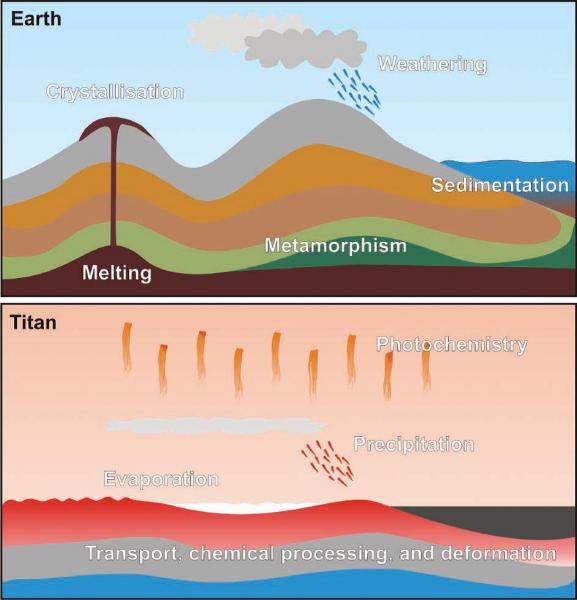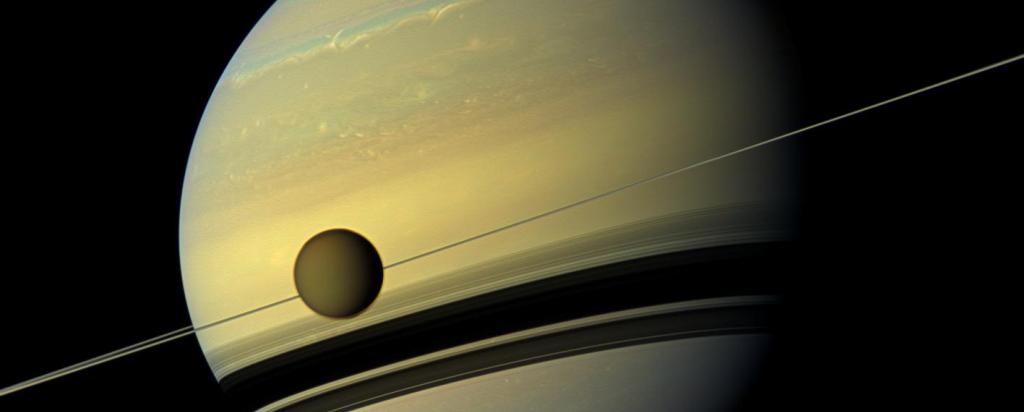

Published on the 9th August 2018 by ANSTO Staff
Researchers from ANSTO and NASA’s Jet Propulsion Laboratory have uncovered the likely mineral composition of Saturn’s largest moon, Titan, revealing a world of exotic organic crystals unlike any found on Earth.
Published in American Mineralogist, the paper offers the first detailed survey of the minerals likely to be found on Titan and their molecular structures using experimental data. Over 50 different organic crystals were identified as probable components of the surface and subsurface of the icy moon.
“A number of Titan’s organic minerals have been studied in isolation before, but this is the first time we have tried to catalogue all the possible solid materials that could form from the organic building blocks we know are present,” said lead author Dr. Helen Maynard-Casely, planetary materials scientist at ANSTO’s Australian Centre for Neutron Scattering.
“Knowing the surface chemistry of planets and moons is one thing, but it does not always tell us what the materials are. Understanding the materials on Titan’s surface is critical for understanding the geology shaping it, as well as its potential for hosting life.”
One of the Titan minerals previously studied was a co-crystal of benzene and ethane, recreated by Dr. Maynard-Casely and her colleagues under cryogenic conditions similar to Titan’s surface. The molecular structure of this co-crystal was determined using the Powder Diffraction instrument at ANSTO’s Australian Synchrotron.
“The information we gained out of this and similar experiments led us to naturally wonder about all the other minerals we might expect to find on Titan, and what properties they might have in common,” said Dr. Maynard-Casely.
Saturn’s golden moon
The largest of Saturn’s 62 confirmed moons, Titan is a frozen world encased within a golden nitrogen-methane atmosphere. Temperatures across the surface rarely deviate from 92 degrees Kelvin (-181°C).
Data from NASA’s 13-year-long Cassini-Huygens mission, which ended last September, revealed that Titan was a geologically active world sharing many features in common with Earth. It is the only moon in the solar system with a dense atmosphere, surface lakes and seas, and its own hydrological cycle.
Despite these similarities, vast differences in temperature and chemical environments result in entirely different mineral formation processes between Earth and Titan. In contrast with Earth’s largely silicon- and metal-based mineral composition, Titan’s minerals are composed of water ice, ammonia, and a variety of hydrocarbons.
These minerals begin to form high up in Titan’s atmosphere. Solar radiation and energy from Saturn’s magnetosphere drive photochemical processes that cause nitrogen and methane to break apart and recombine, generating a range of new organic compounds.
As these reactions continue, ever-more complex molecules continue to grow as they slowly rain down upon the frozen surface.
These minerals begin to form high up in Titan’s atmosphere. Solar radiation and energy from Saturn’s magnetosphere drive photochemical processes that cause nitrogen and methane to break apart and recombine, generating a range of new organic compounds.
As these reactions continue, ever-more complex molecules continue to grow as they slowly rain down upon the frozen surface.
Classifying Titan’s minerals
Understanding Titan’s chemical environment not only enabled researchers to recreate specific Titan minerals in their labs for analysis, but led to the creation of three photochemical models that could predict which materials should be deposited on Titan’s surface and to what proportion.
Dr. Maynard-Casely and her colleagues investigated the possible crystal structures that the deposited materials could form using the predictions made by these photochemical models.
The final 54 structures were identified following an exhaustive search of over 800 000 recorded entries in the Cambridge Structural Database, the world’s largest online repository of organic molecular crystal structures.
“We discovered that all the likely Titan minerals fall into three categories: what we call molecular solids, molecular co-crystals, and hydrates. There may yet be more categories out there to be found,” said Dr. Maynard-Casely.
The distinction between these three categories is based on the intermolecular interactions that hold the crystals together.
“Molecular solids are in some ways the simplest type: they are solids of pure molecules that are mainly held together by van der Waals forces,” said Dr. Maynard-Casely.
“Despite their simplicity, molecular solids have the potential to drive geological processes. At the low temperatures on Titan they can undergo phase transitions from disordered to ordered structures, drastically changing their density in the process.”
The second category, molecular co-crystals, are more complex materials formed by mixing different molecular solids in fixed proportions, which could naturally happen in the liquid hydrocarbon seas of Titan.
As Dr. Maynard-Casely’s experiments with the benzene:ethane co-crystal demonstrated, molecular co-crystals are able to expand significantly even in the narrow temperature range encountered on Titan, helping them to shape Titan’s surface and subsurface features.
The third category of materials, hydrates, form as the photochemically-produced molecules from the atmosphere interact with the underlying water ice layers of Titan.
“Some of these hydrate materials might be the strongest of the surface materials on Titan,” said Dr. Maynard-Casely.
Implications
This world-first survey revealed a contrasting set of physical and mechanical properties among Titan’s minerals that could drive the formation and propagation of large-scale cracks, which may in turn play an essential role in shaping the observed surface features of Titan.
In addition, several of the identified molecular co-crystals and hydrates are able to swap out molecules to form a variety of structures, creating variable mineralogy in the crystals.
This capability may lead to the formation of chemical gradients that life could naturally exploit, raising the potential for astrobiological activity on Titan.
“Our next step will be to expand our list of minerals to account for trace elements that may have reached Titan through, for instance, meteorites bombarding the surface,” said Dr. Maynard-Casely.
“We also know there’s some gaps in our existing list, as some of the materials like butane and butatriene had no crystals structures in the Cambridge database. We can now pinpoint these specific materials as prime candidates for future investigation.”
ANSTO offers neutron beam, synchrotron beam and materials facilities to support research in planetary science.
